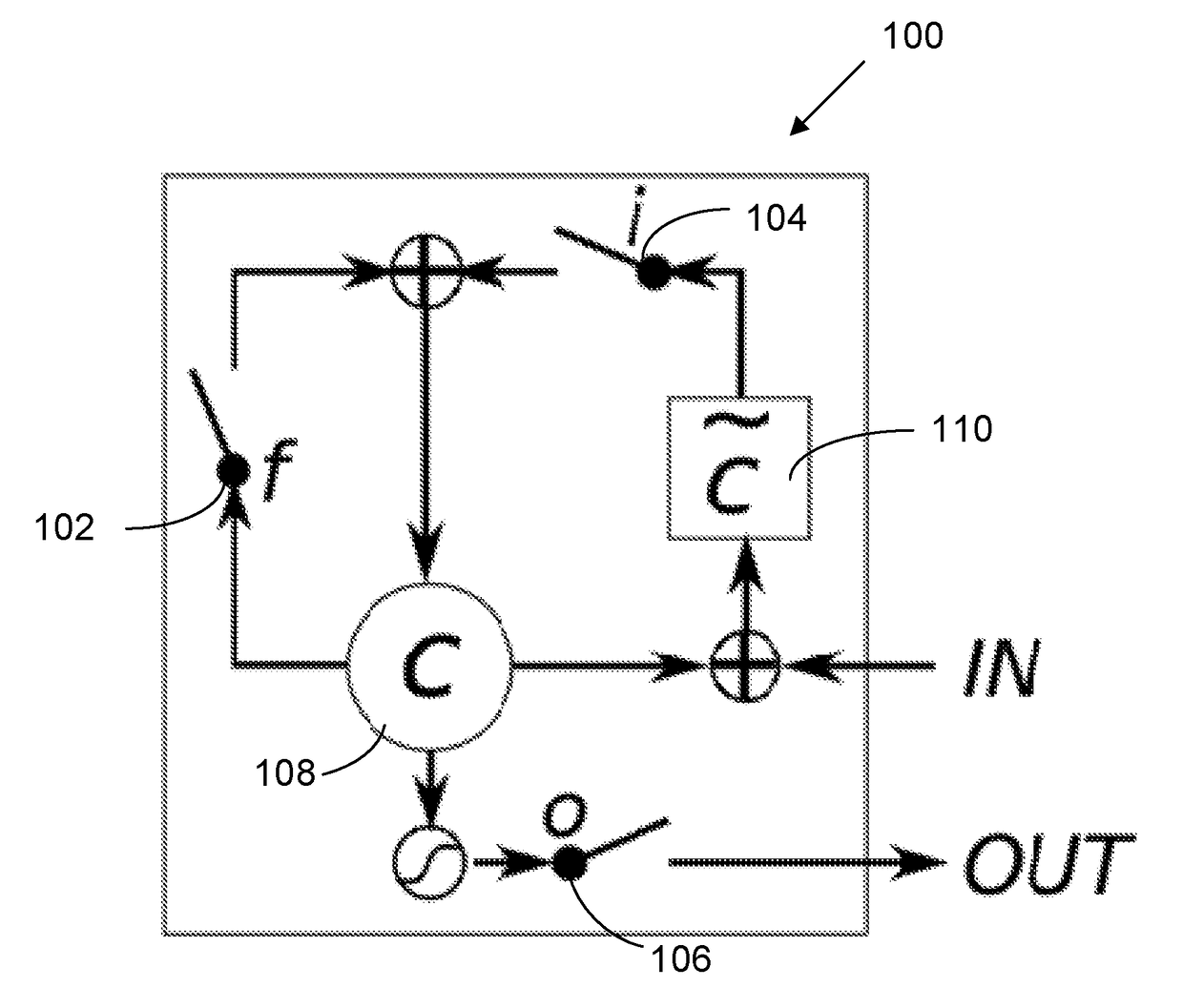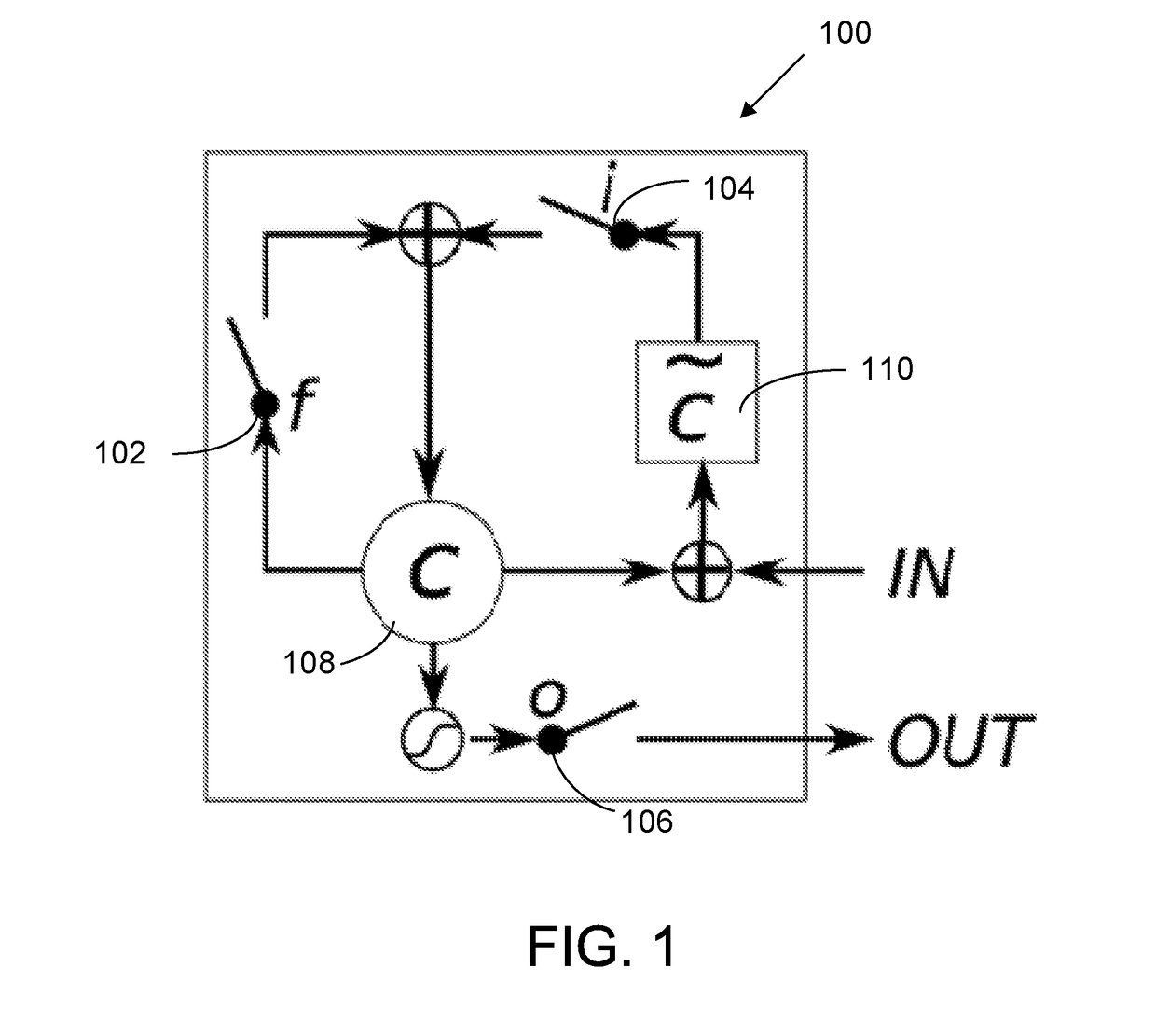Differential recurrent neural network
a neural network and recurrent neural network technology, applied in biological neural network models, complex mathematical operations, instruments, etc., can solve problems such as state instability, gradient vanishing in time, and rnn with backpropagation, and achieve the effect of improving the convergence of gradient descent methods and increasing the curvature of hessian
- Summary
- Abstract
- Description
- Claims
- Application Information
AI Technical Summary
Benefits of technology
Problems solved by technology
Method used
Image
Examples
example 1
5.1 EXAMPLE 1
Memory Set / Recall
[0153]To illustrate what the differential RNN architecture can compute, a simple memory 1200 is implemented. The memory 1200 can be read at any time from the output 1202. The output value comes from the state component 1210, and is also fed into the trainable transition component 1208. The differential non-linearity component 1212 completes the loop. This example illustrates how the function Set, which can also be viewed as Forget if the new value is 0, can be implemented even though the differential RNN does not have any gates, let alone a forget gate. The RNN receives a value Value from its input 1204, but it is only stored in memory when the Set input 1206 is 1. Otherwise, the Set input 1206 is assumed to be 0. The trainable transition component 1208 is a simple matrix W. In this example, the weights are set by hand, but they could of course be trained. This Memory Set / Recall functionality can be implemented with a single state and the architecture s...
example 2
5.2 EXAMPLE 2
Building Gates
[0157]This example provides a guide to building simple non-linear functions such as a logic gate 1300 using a portion of the differential RNN architecture. Assume A, B, are a binary signal 1302 (taking values in {0,1}), and S is a signal 1304 taking value in [−V, +V]. The architecture illustrated in FIG. 13 is employed, which includes the trainable transition component 1306 and the differential non-linearity component 1308. As the output 1310 of the logic gate does not need to be stored in this example, the state component is not used.
[0158]To implement y=A∧B)S, choose:
W=[-2V+V+V1+2V-V-V1](77)Proof:[-2V+V+V1+2V-V-V1][1ABS]=[V(A-1)+V(B-1)+SV(1-A)+V(1-B)+S]=[y+y-](78)
ABy+y−y = σ(y+) −σ(−y−)(A ∧ B)S00−2V + S ≤ 0 2V + S ≥ 0 0001−V + S ≤ 0V + S ≥ 00010−V + S ≤ 0V + S ≥ 00011SSSS
[0159]This formula is easy to generalize to y =(A∧B∧C∧. . . )S by expanding the matrix W. It is also easy to independently negate any of the binary variables. For instance, to negate B, ...
example 3
5.3 EXAMPLE 3
[0162]This next example illustrates a two-state component and how the differential RNN can implement a counter. The stop watch 1400 has 3 inputs: Start 1402, Stop 1404, and Reset 1406. It has one output 1408, which counts the steps while the stopwatch is on. This functionality can be implemented with a two-state state component 1410 and a trainable transition component 1412 regularized to a linear function. The architecture is illustrated in FIG. 14.
[0163]With the non-linearity functions associated with the differential non-linearity component 1414 defined as:
y0=σ(y0−)−σ(−y0−) (83)
y1=σ(y1−)−σ(y1−) (84)
σ(x)=max (x, 0) (85)
[0164]To show feasibility, let x0 track whether the stop watch is on (x0=1) or off (x0=0). Use x1 to count the time steps. The state of the next x0 is given by the following table:
StartStopNext x0y0(Start ∨ Stop)(−x0 + Start)00x000101−x0 + 1−x0 + Start010−x0 + 0−x0 + Start111−x0 + 1−x0 + Start
[0165]The Start and Stop are not assumed to be...
PUM
 Login to View More
Login to View More Abstract
Description
Claims
Application Information
 Login to View More
Login to View More - R&D
- Intellectual Property
- Life Sciences
- Materials
- Tech Scout
- Unparalleled Data Quality
- Higher Quality Content
- 60% Fewer Hallucinations
Browse by: Latest US Patents, China's latest patents, Technical Efficacy Thesaurus, Application Domain, Technology Topic, Popular Technical Reports.
© 2025 PatSnap. All rights reserved.Legal|Privacy policy|Modern Slavery Act Transparency Statement|Sitemap|About US| Contact US: help@patsnap.com



